OUR TRADITIONAL CULTURAL HERITAGE: ANATOLIAN TURKISH HAND-WOVEN CARPETS AND KILIMS
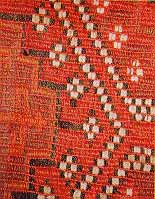
Turkish knotted carpets and flat-weaves occupy a very important place in our cultural heritage as ethnographic documents relating to the Turkish inhabitants of Anatolia in each succeeding epoch, like all other such historical documents, carpets and kilims clearly reflect the values of the period in which they were made. It is thus essential that priority should be given to precautions to be taken without delay in order to preserve these old carpets and kilims from wear and decay and, at the same time, to prevent their being smuggled abroad.
The textile fragments, weaving tools and dye materials yielded by archaeological excavations corroborate the theory that flat-weaves have been produced in Anatolia since the Neolithic period, but the amount of material so far obtained is not sufficient to provide an answer to questions such as how and when flat-woven or knotted rugs were first produced. Nevertheless, the fact that the earliest specimens of knotted carpets so far discovered were found in Turkish regions in excavations carried out on Turkish burial mounds confirms the belief that this type of rug was first woven and used by the Turks.
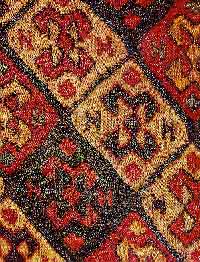
The way of life and philosophy of the Turkish tribes and nations who occupied the vast expanse of territory extending from Central Asia to Anatolia were enshrined in the thousands of colours and motifs incorporated in fabrics that have preserved their expressive power and character to the present day. From this point of view, Turkish carpets occupy a very special position in our cultural heritage.
The individual weaving forms and techniques to be found in the traditional Turkish hand-woven carpets, the significance and symbolism of the motifs and the dyes and colours employed, all reflect the socio-cultural and socio-economic values of the period in which they were produced.
The motifs and colours typical of Turkish carpets and kilims constituted an important medium of expression for the weaver and his community. The values of the period to which it belonged may be reflected in the twist and quality of the wool, the manner in which the dye was manufactured and from what plants or insects it was produced, the fineness or looseness of the stitch and, most important of all, the symbolic significance of the motifs and the aesthetic dimensions of the stylisation. Turkish hand-woven carpets may thus be regarded as source material for the study of the anthropology, ethnology and ethnography of the periods to which they belonged, as well as of the general technical and economic background.
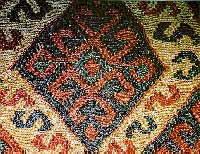
Carpet-weaving, carried out on various types of looms without the benefit of modern appliances and demanding most meticulous handling at every stage of its production, from the preparation by the old traditional methods of the warp, weft and knot to the application of the natural dyes, is one of the few Turkish handcrafts to have continued with the same scrupulous application to detail right up to the present day.
Apart from the dyeing and weaving, which form the technical basis of the knotted carpet, the most important feature from the point of view of the cultural heritage involved is the nature of the motifs employed. The Turkish craftsman possessed the ability to imbue his hand-woven fabrics with his own identity, his social position and communal traditions. The marks stamped on the tents and horse-covers in the high-lands and summer pastures which are also to be found incorporated in their fabrics, have survived in their fabrics, have survived in the form of aesthetic variations the first inventors could never have foreseen. That is what distinguishes the Turkish carpet so very clearly from all other carpets in the world.

All Turkish carpets, from those of Eastern Turkestan to those produced in Baluchistan, Khorasan, the Caucasus and Anatolia, are characterised by the distinctive designs that raise our traditional handcrafts to the highest artistic level.
The motifs employed in Turkish carpets are so varied and can be classified into so many subcategories that they constitute, as it were, a great fan stretching from Thrace to Kars. From the Sivas region emerge the Sarkisla, Zara, Kangal and Divrigi carpets characterised by a remarkable wealth of symbolic expression forming one of the links in the rich chain of Turkish tradition. Motifs differing markedly in form and detail can be found in Anatolian kilims from Yagcibekir to Dosemealti, from Kula to Çanakkale.
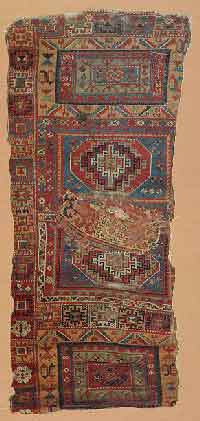 The most important distinguishing feature of the motifs employed in Anatolian carpets is the "symbolisation" imposed by the traditional weaving techniques. The linear values of these woven fabrics constitute the symbolic representation of the ideas which the Turkish woman wishes to express. Perhaps it would be an exaggeration to say that all the motifs employed in carpets and kilims bear a symbolic significance, but it is usually possible to find a hidden connection between the "visible motif" and the "under lying motif". The symbolic values conferred upon the objects are stylised by the Turkish weaving technique itself. The language of the motifs is the language of any-one who can understand.
The most important distinguishing feature of the motifs employed in Anatolian carpets is the "symbolisation" imposed by the traditional weaving techniques. The linear values of these woven fabrics constitute the symbolic representation of the ideas which the Turkish woman wishes to express. Perhaps it would be an exaggeration to say that all the motifs employed in carpets and kilims bear a symbolic significance, but it is usually possible to find a hidden connection between the "visible motif" and the "under lying motif". The symbolic values conferred upon the objects are stylised by the Turkish weaving technique itself. The language of the motifs is the language of any-one who can understand.
Each of the Turkish carpets and kilims produced by a very natural process under certain conditions and in the course of a certain period bears the mark both of a certain period bears the mark both of a cultural heritage and a work of art, but it differs from other works of art in necessitating an evaluation of the weaver and his world.
The motifs employed in Anatolian Turkish carpets have never been over-uniform in character. In their long migrations, the tribes and peoples adopted what was "good" and "true" from the cultures with which they came in contact. The "double S" motif in the skirt of the garment worn by Warpalawas in the rock relief at Ivriz dating from around 1250 B.C. can be found in a number of Sarkisla carpets that we have dated to the 16th century.
What is the present condition of these valuable old carpets and kilims which, for the reasons given above, occupy cuch an important place in our traditional heritage and cultural history? But before answering that question we should perhaps ask ourselves what, apart from the carpets and kilims preserved in the museums and archives belonging to the Ministry of Education and the General Directorate of Pious Foundations, we really know of the extent of the legacy we have inherited? Moreover, although hundreds of carpets and kilims are carefully preserved in the rich collections housed in the Museum of Turkish and Islamic Arts, the Vakiflar Carpet and Kilim Museum, the Topkapi Palace Museum and the Konya and Sivas Museums, there would appear little we can do to halt the gradual disintegration and disappearance of the carpets and kilims scattered here and there in remote corners of Anatolia. It is thanks to the Turkish tradition of pious endowments that rugs other than those that have remained in the house in which they were actually woven have managed to come down to us from the depths of the past. The benefactors who with their own modest resources, built the mescits to be found in even the smallest village, also furnished them with rugs and kilims, and to these were added several of the finest specimens produced over the centuries by the looms in the various houses. There were also a number of prayer-rugs and carpets specially woven for the mosques, to which they were duly presented. It is thanks to this tradition of pious endowment that our cultural heritage of carpets and kilims has survived to the present day.
Wool is a fragile material that wears very quickly even under normal conditions, and many of our carpets were left for centuries in damp corners under the worst possible conditions, without any thought of their value and without the slightest attempt to air and maintain them. Even at the present day, torn pieces of valuable old carpets and kilims are placed under stoves, on thresholds or ablution stools, or nailed on wooden stairs. All the rugs in a particular mosque are sold off to make way for a large machine made carpet covering the whole interior. Or if we don't actually sell them, we barter them for wood or coal. As for carpets that have been carefully preserved by the personnel of the mosque, as in the Great Mosque at Sarikisla, we resort to all sorts of expedients to prevent them being stolen by people who could gain a great deal of money by their sale.
Carpets and kilims are the most attractively presented of our cultural goods and the easiest to smuggle abroad, while the recently implemented free market regime regarding items of an ethnographic nature even further facilitates illicit sale. The Very restricted powers of control with which the museums are endowed combined with the very small number of experts in this field makes it relatively simple to smuggle these valuable carpets and kilims abroad. No inventories have been drawn u of the valuable old carpets and kilims in Anatolia apart from those in the museums, and we are continually being amazed to find our most valuable carpets appearing in advertisements in various European and American magazines and periodicals.
There are now a number of very useful institutions in Turkey, such as the Turkish Cultural Research Association, the Society for the Encouragement of Turkish Carpet-Weaving and the Turkish Carpet-Weaving Foundation that make it essential that we should look at the whole problem in a new light.
Carpet-weaving is of great cultural and economic importance, and judicious investment in this field could provide employment for millions of workers at home and, by using the "Turkish Image", create a wide market abroad. But to regulate the future of a cultural sector one must first have a very good knowledge of the culture itself.
Anatolia might be decried as a vast treasure-house of the most valuable carpets and kilims. Those reproduced in these pages represent the few remaining specimens to have survived to the present day under the most adverse conditions. One might very well compare them to the fragmentary remains from Catalhöyük, Bogazköyü or the Kubadabad Sarayi. The whole history of the Turkish people is incorporated in their colours and motifs.
1.This topic has been reviewed in the light of the paper entitled "Suggestions concerning measures to be taken for the prevention of theft and damage with regard to the old carpets and kilims in Turkish moques" presented at the "Symposium on the smuggling, damage and preservation of old objects of historical or cultural value."
2.As a supplement to the work of Kurt Erdmann and researchers belonging to his school on the history of knotted carpets, see the several works published by Prof. O. Aslapanapa. S. Yetkin and N. Diyarbekirli.
Source: Türkiyemiz, Culture and Art Magazine, October 1991
By : Fahrettin & Naciye Kayipmaz
Ladik Carpets
Throughout the ages, the people of Anatolia have reflected their handiwork, their labours, and their assiduity as cultural and artistic sensitivity and love in the form of carpets, kilims, pillows, and tapestries.
The people of Anatolia have successfully imbued these hand-woven works with the unique qualities of the region in which they live, and with the strength of their art, their taste, their world view, their longings, and their love they have managed proudly to present these within a philosophy of existentialism to future ages.
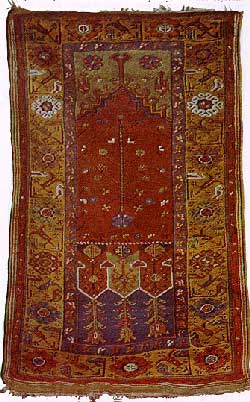 18th century Ladik carpet with ewer and tulip motifs.
18th century Ladik carpet with ewer and tulip motifs.
The most important of the carpet centres consisting of Usak, Gordes and Kula reaching back into the ages past of Anatolia is Ladik. Ladik carpets, woven for trousseaus or prayer are one Turkish carpet which is eagerly sought by museums and collectors everywhere in the world.
In Ladik carpets there exists an image and spirit, a richness of form and design, and a harmony of colour of the utmost brightness and liveliness. In general, ladies and young girls weave rugs and carpets in Anatolia. When we examine Ladik carpets we understand that the young girls are not weaving them for the purpose of selling them and earning money. Nor is that the purpose of their mothers or fathers. As a form of education and as a preparation for motherhood, during the preparation of the marriage items which we refer to as the trousseau and while readying their embroideries, their tablecloths, their stockings, and their embroidered headdresses they direct their daughters towards the weaving of carpets which require more patience, more time, and more proficiency -that is more skill-than these. And the daughters do it willingly. It is a fact that Ladik is a region which is rich in agricultural resources. For this reason, the people of Ladik have not tended towards commercially inspired carpet making. They have adopted only the weaving of carpets and pillows as trousseaus, gifts, and as an artistic force. From the Sixteenth Century down to the last fifty years, they have presented their most beautiful examples of this.
In Ladik carpets we witness to the full the taking form of repose, affluence, and happiness. The richness of colour as well demonstrates their optimism, the fact of their kind words and smiling face. A carpet weaving girl from Ladik most beautifully reflects the feelings inside herself in a work she weaves as if she were preparing a painting, whose wool she has clipped from the sheep of her own parents flocks, whose dyes she has boiled from plants from her own pastures, and whose yarn she has spun and dyed. Within a wealth of nature and the utmost in prosperity and sensitivity, a carpet weaving girl from Ladik infuses her maidenhood longings into these carpets with each and every knot. In Ladik carpets, each colour speaks a different language. Yellow expresses passionate love, yellowing and fading away. Green, as is usual, is one's goal. Blue is hope. White is cleanliness and happiness. Black expresses sorrow, while pink expresses innocence. In Anatolian rugs and carpets, colours also have their own forms of expression, their own things to say. The special quality of each region finds its most beautiful form in its rugs, carpets, and kilims.
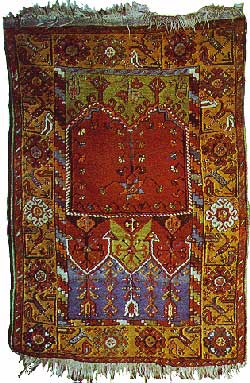
What we refer to as root dyes, the dyes employed in rugs, are obtained from the leaves of various plants, from their roots, and from their fruits. Red is obtained from the bark of the red pine and from the leaves of the hazelnut tree; yellow and its varying tones from broom and from the flowers, stems and roots of plants such as sumac, spurge, and saffron; brown from the bark of gall oak and black oak, black oat root, leaves of the walnut tree and walnuts; green from wild mint; black from sumac and soot; blue from jute. Every region in which carpet weaving is carried out possesses pasturage where the dyes used for dying wool may be obtained. Such pasturage is called boyalik (literally; "dye pot"). The plants used for obtaining dye growing in these pastures are specially raised, and these formulas have over the centuries entered the daily lives of carpet weavers, and thus Anatolian carpet making has always characteristics. Designs have the same quality. These designs are virtually the mirrors of the latitude and longitude of the people of the region. Among Anatolian carpet weaving, Ladik carpets generously present to all viewing them their wealth of design and form in the form of a magnificent composition. A Ladik carpet is like a book. No matter what side you look at it from, you may read it with pleasure. It is like a letter, sometimes bringing good news. Sometimes in the complementary intertwining of red and blues it gives voice to a joy of living with its sweet colours. The brown tending towards copper infuses a feeling of confidence. The nested geometric design in the form of rectangles is a symbol of the garden of the heart. The young girl of Ladik embellishes this garden of the heart with symbols and signs of all the possessions she wants. A carnation is an indication of desire. Flowers and stars are happy looks at the future.
In Ladik carpets, the colours and designs are the most lively expressions of a national tradition. Every line speaks a different tongue. The stylised animal figures in motif form are the form of ancient Turkish totems reflected in carpets. The symbols of luck and prosperity in the form of hooks, the health charms, the snakes and dragons, the convolutions, the birds, stars, flowers of paradise, and such symbols of articles as combs, rakes, ewers etc. bespeak all the beliefs, the whole spiritual world of the people of Ladik. Among other Anatolian motifs are also included figures of the stylised dragon referred to popularly as tilsim (charm) which is a symbol of health and happiness, the peacock known as the bird of paradise the mythical simurg (the Emerald Phoenix) which symbolises charity towards people and help for the needy, the double headed eagle, rooster etc. known to have been a totem among ancient Turks and representing the ruler and his authority. In carpet, the spike of grain expresses prosperity; the rose, tulip, carnation and other flowers represent the gardens of paradise; the branching flowers represent the infinity of life (the Tree of Life); the cypress tree represents eternity (reincarnation) owing to its permanent verdure as opposed to the ephemerality of life. The pomegranate and its flower is the fruit of paradise. In Anatolia it is considered sacred.
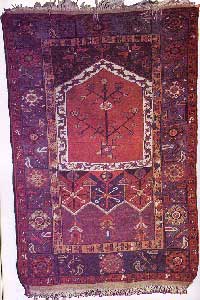
Ladik carpets generally have a mihrab on them, which shows that the love of worship and pious belief is widespread in Ladik. Various from of the mihrab are visible in Ladik carpets. The stepped arches of the mihrab, the lanterns hung from it, the varieties of their chains, the candlesticks placed at either side, the ewers for performing ablutions are all characteristic of these carpets. The ewer is a symbol of belief in the need to perform the ritual ablution and for cleanliness. An ewer containing a flower, sometimes takes the shape of a vase, and is beyond colour, letters, and voices. The candelabra and the lanterns swinging like pendulums right in the middle of Ladik carpets spread the good news of an endless and boundless light.
Priceless examples of Ladik carpets woven for two hundred fifty years by the hennaed fingers of the women of Ladik adorn museums. Whether in Karapinar in the vicinity of Konya, in Kavak, Karaman Kizillar,Inluce, or Sille, the colours of the rugs, their designs, their borders, and their motifs continue on and on with a habitually which undergoes little change. The principle designs and compositions are part of a whole. The carpets of Ladik must be held separate from this view. A variety of colours, ranging from pale pink to copper red, pearl white, and Seljuk indigo, with a variety of models and motifs smile at us from various Ladik carpets in the softness of their wool. The great majority of Ladik carpets are woven as prayer rugs. For this reason, when one thinks of Ladik carpets the mihrab comes to mind, as do a variety of mihrab compositions. When you look at one Ladik carpet, the mihrab is as wide as possible, lacking a single mark on it. One might race a horse on this field of Ladik red. On another mihrab its four corners are decorated with flowers like a garden of one's heart's desire, and one's eyes find not a place in which to take a step. Another carpet is wholly washed in a state of snow-white sacred belief. Or you might look and see that our carpet weaving girl from Ladik has woven on the loom of her heart a carpet which, with is three great carnations and powder pink involutes gives us a "good morning!" look, extending its hands in supplication.
One must admit one fact. Ladik carpets, which are made entirely of wool, are not knotted very tightly, in fact they are loose. This is some what due to the curly nature of the woollen carpeting yarn; unlike cotton thread, woollen yarn is not entirely straight. As both the warp and woof are of wool, a loose weave must have been chosen to prevent puckering or wrinkling.
Because of Ladik carpet making. Ladik carpets have for ages been the pride of Anatolian carpet making and have taken the leading place in museums, carpet books and catalogs. As for Ladik carpet making today, it is entirely divorced from its old tradition, and partly owing to economic reasons never goes beyond imitations of Sivas and Kayseri rugs, unfortunately. Though with regularisation and revival Ladik carpet making could earn much for the country's economy. This sacred duty we must perform in the shortest possible time. This we are obliged to do.
Source: Antika; The Turkish Journal of Collectable Art, May 1985, Issue: 2
By Feyzi Halici
Reference: http://www.turkishembassy.org








